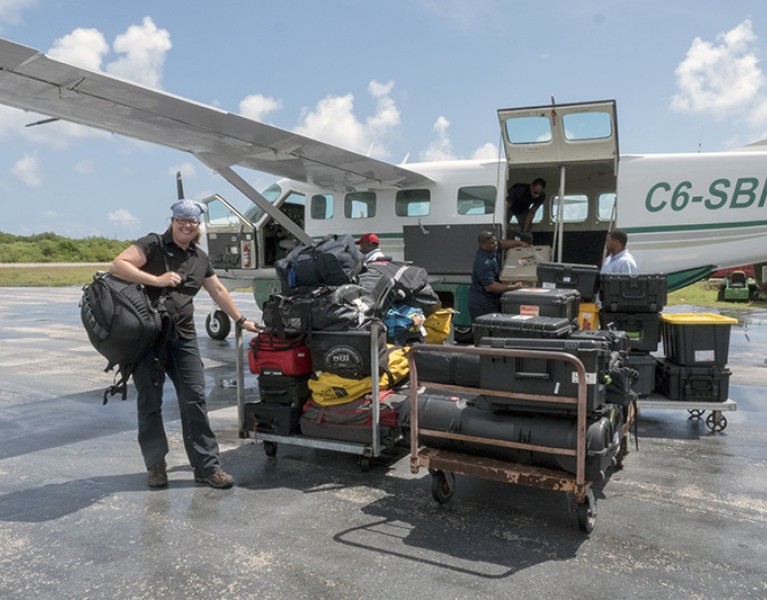
The Ultimate Traveler: 100 Tried & True Travel Tips
Table of Contents [Show]
100 Travel Tips for Every Adventure
Jill Heinerth has spent a lifetime traveling the globe on expeditions and filming projects. She shares her top 100 travel tips to make your journey more relaxed and earth-friendly.
Before You Go
- Global Rescue - If you are going to be in a remote place, make sure you have evacuation insurance to get home in the event of an accident.
- Medical Insurance - Ensure you are covered adequately in case of misfortune. Divers Alert Network (DAN) offers worldwide coverage for diving accidents and supplemental travel insurance with proceeds that support diving medical research. Other sport organizations have particular policies that cover accidents, too.
- Gear Insurance - Do you need to cover sporting gear or cameras for loss, damage or theft? Get it covered before you go.
- Credit Cards - As much as I hate paying annual fees, some credit cards have a lot of value attached to their services. Cards like American Express may cover everything from free use of airport lounges to gear, car rental, and medical insurance. Most offer a free buddy ticket, too. If you travel frequently, it's worth considering.
- Checklists - I’m a fan of using lists for packing. Bring it with you, so you are organized on the way home and get everything into the right bag for weight limits. Having a list also helps if you're pulled into additional inspections at airports.
- Computer Backup - As a precaution, run a backup of your laptop before you leave home in case it is lost, stolen or damaged on the trip.
- Identification - Make a photocopy of your important travel papers, such as your passport and Driver’s License, and keep the copy on your body during the trip. It is not unusual for a hotel to hold your passport until you pay your bill. In case of loss, you have all the information you need for replacement.
- Credit Card Info - Ensure you have access to credit card information in case your wallet is lost or stolen. You want the card numbers and the toll-free phone number for card cancellation and replacement.
- Download - Do you want movies, podcasts, or e-books to read on holiday? Fill up your computer or phone well in advance of departure. Load up a travel guide for your destination.
- Local Cash - Get a little local cash in advance of the trip (Travelex online), and make sure you know the local exchange rate so that you are not cheated or over-charged by foreign exchange providers at your destination. Airports have the highest fees and ATMs with no fee cards are generally best.
- Navigation - Preload your phone with offline local maps and transit information so that you won’t need to use expensive cellular data services once you land. Cache Google maps or use HERE maps.
- Photograph - Take a picture of itineraries, hotel information and other details you might need to access once you land.
- Power Up - Bring a phone charging battery or charging case and extra cable in case your smartphone dies.
- Know Your Embassy - If the very worst happens on a trip, you'll want to contact your home country’s embassy. Load the contact details on your phone.
- Check Rates - Before you go, check out international calling and data rates and options, so there are no surprises. Sometimes local SIM cards are a good option. Make sure you arrange your phone settings appropriately so that you don’t pay for unwanted calls or data.
- Speak to Me - Learn common phrases of the local language. Store the phrases on your smartphone.
- Alerts - Let your credit card know you will be traveling to avoid being locked out by the fraud department.
- Backup Funds - Always have a plan for a declined credit card. Carry a second card from a different company and a small amount of local currency.
- No Fee Bank Cards - Use a no fee bank card to get local currency from ATMs as needed.
- Cheap Flights - Use web searches for the cheapest flights and cross reference with the airline before buying. Momondo, Google Flights, and Skyscanner offer creative ways to search destinations, prices and the cheapest days to fly.
Packing
- Small Footprint - Rolling your clothes and socks saves space.
- Compress It - Use silicone compression sacs and dry bags to further squeeze the air out of your clothes and maximize packing space.
- Electronics - Get a cable bag to organize your charging and computer cables.
- Storage - If you are going to shoot a lot of photos, take a hard drive for backup and storage.
- The Cloud - If you think you will have sufficient bandwidth, backup your photos to the cloud for easy access that eliminates the need for a backup hard drive.
- Gifts for Kids - A small token gift can go a long way when you are abroad. A flag pin or interesting sticker is a far better gift than giving children money or candy.
- Comfort Items - A pillow, eye mask, and earplugs might be lifesavers on the plane or even in your hotel.
- Dress for Comfort - You want to be warm and comfortable on a long plane ride. Cozy, loose fitting clothing, compression socks and a hat you can pull down over your eyes are helpful.
- Ziplocks - Ziplock bags are great for packing clothes. Use the soft clothing packs to pad more sensitive or fragile items. If you roll a fragile object in clothing, place it in a bag, so it doesn’t get accidentally dropped during luggage inspection. Use heavyweight models so they can reused.
- Organize - An organized suitcase will look that way on an airport x-ray, preventing the likelihood of a supplemental security search.
- Saving Weight - If your weight limits are tight, use soft baggage like a duffel like the KÜHL MARAUDR KARRYALL. You can line it will corrugated plastic to make it sturdier.
- Shelf Liner - Cushy rubber shelf liner is excellent for protecting fragile items.
- Battery Boxes - Extra lithium batteries must be carried in hand luggage. Protect the contacts with tape, or store them in lightweight battery boxes.
- IKEA Batteries - The best rechargeable batteries are Eneloop brand by Sanyo. Buy them under IKEA’s house brand and save significantly.
- RFID - Think about getting a small RFID-safe card-carrier or wallet, or line your wallet with aluminum foil to defeat identity thieves who roam in airports, train stations, and tourist spots.
- First Aid - Pack a small kit with pain reliever, Benedryl, decongestant, antacid, cough drops, bandages, activated charcoal pills (for diarrhea and minor allergic reactions), and antibiotic cream.
- Lost Bags - Photograph your luggage prior to departure in case the airline loses your bag.
- Power - Consider packing a small 240V power strip with USB outlets for charging multiple devices, and don’t forget a local outlet converter.
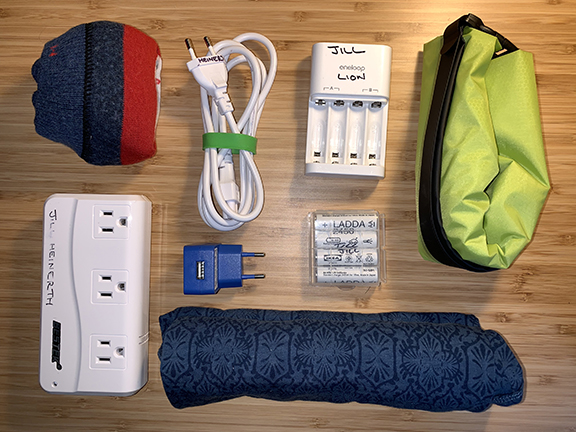
Getting There
- Nutrition - Free meals on airplanes are becoming a rarity unless you're traveling on long-distance routes. Take food from home to save money, but make sure the items are not liquid or they might be confiscated at check-in.
- Headphones - Bring headphones for the plane. Bluetooth earbuds are not allowed on some flights, and the cheap headphones offered on the plane usually come with a fee attached.
- Apps - Download your airline app. You can use a digital boarding pass for check-in. In the event of a flight delay, call the toll free number rather than lining up at the terminal lines. You will get a new flight faster. That said, you still might have to lineup for meal vouchers when applicable.
- Water Bottle - Water bottles are essential, but considering taking a flat hip flask instead. They're easier to pack. Vapur collapsible bottles are even smaller.
- Double Walls - A double wall stainless bottle might be good for your morning coffee or tea. It will stay hot and negate the need for using disposable cups and lids.
- Cutlery - Pack a titanium spork, bamboo cutlery, and stainless straw so you can avoid consumption of single-use plastics.
- Tiffen Box - If you bring your food for the flight, store it in a stainless Tiffen Box. This doubles as a mess kit at your destination. Don’t eat out for every meal. Buy groceries at a local shop to save money.
- Need to P - Women should consider bringing a Pee Funnel. Being able to stand up for urination can be discreet and is appreciated in less than clean restrooms.
- Shower in a Box - Wet wipes are a life saver. Create your own by placing small fabric pieces in a small dry bag with a mix of water, alcohol and a few drops of antiseptic tea tree oil. Bring an extra dry bag or ziplock for the used wipes so you can take them home with you.
- Business Cards - Conference trips often come with a mound of paper and business cards. Get the Adobe Scan app or use your Note feature to scan business cards and materials instead of using precious printed resources.
- Tissue - Never assume that toilet paper is available or free. Take your own.
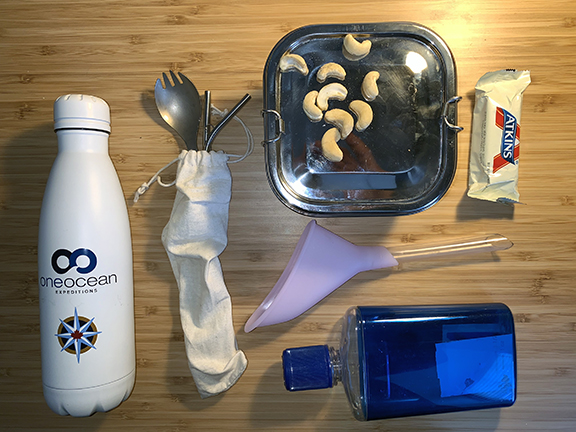
On the Ground
- The Best Kit - My favorite piece of gear is a waterproof, silicone roll-top bag. I can use it as a pillow. I can do a load of laundry in it by filling it with water and a little soap. I can also use that water-filled laundry bag as a substitute for free weights in the hotel or camp.
- Flashlight Safe - I use an old, empty waterproof flashlight to store a small roll of cash. If you get robbed, it won’t be a target.
- Credit Card Purchase Protection - Look closely at your credit card to see if it offers purchase protection for your trip or valuables like a new camera. Most people are not even aware of the refunds they might get if their luggage or camera is lost or stolen.
- Nexus or Global Entry - For a minimal fee you can enroll in Nexus or Global Entry. It will take months to process but is current for five years. You can skip long airport security lines and breeze through customs quickly. It can mean the difference between making an international connection and not.
- Do Not Disturb - If you are a little leery about security in your hotel, use the Do Not Disturb sign to forgo cleaning and interruption of your personal belongings.
- Making it Dark - If you find an annoying streak of sunlight streaming through your curtains, use a hotel trouser hanger to clip the curtains shut.
- Hiding Places - If you can’t think of a place to protect your laptop computer, look in the bathroom. Perhaps there is a spot under the sink to tuck it away.
- Pac Safe - If you want to create your own hotel safe, look to the company Pac Safe for a lockable steel mesh cover for your pack. You can secure the entire bag to the plumbing in the bathroom.
- Weapons of Choice - These days you might be able to travel with a small knife on a plane. Some countries won’t permit carrying a knife for any reason. If you feel like you're in danger while walking, use a small carabiner as brass knuckles or your stainless water bottle to pack a punch. Then run as quickly as you can to escape further confrontation.
- Sleep Sac - A silk sleeping bag liner is a piece of luxury, especially in dodgy places where you fear getting bitten in your sleep. Always scrutinize bedding before exposing yourself to critters like bed bugs.
- Credit Card Tool - A flat credit card sized multi-tool is worth its weight in gold.
- Soda Can Safe - It looks like your favorite soda and disguises a secure holding area under a screw off lid.
- Key Safe - Small valuables, cash, and keys fit in a magnetized box. It can be stashed in your hotel room or on the body of the car while you head off for a swim on the beach.
- Underwear Safe - I’ll leave it to you to look this one up on Amazon. What appears to be a set of really filthy men’s underwear is instead a place to stash your cash. Nobody in their right mind would dare disturb dirty britches tossed on the floor.
- Camera Phone - Your smartphone is a capable professional camera. Download an app like FilmicPro for the iPhone to gain full manual control over your phone instead of taking a larger DSLR.
- Public Wifi - Accessible Wifi is handy, but avoid logging into bank accounts or using passwords at places like airports.
- Free Wifi - McDonalds, Starbucks and local libraries are great sources for free wifi.
- Sunscreen - Bring along sunscreen from home to avoid high prices in tourist locations. Don’t forget to use it!
- Lock It - Always bring a small combination lock if you plan of staying in dorms or hostels.
- Sharing - Use the sharing economy, and hospitality websites to meet locals and save money. Couchsurfing offers free lodging. WarmShowers caters to cyclists. Airbnb connects with homeowners who wish to rent space. Ride sharing apps are cheaper than taxis. Getaround allows you to rent people’s unused cars by the hour.
- VPN - Use a VPN to protect yourself from hackers, and malware that can find you on unsecured networks.
- Google Translate - If you can use phone data, Google Translate is the easiest way to communicate. Let people read a complicated question or type a complicated answer or directions.
- Get Up - Early morning is the best time to avoid crowds at attractions.
- Buy Passes in Advance - Many attractions, ferries and tours offer passes online at discounted prices. You’ll save money and jump the line when you arrive.
- Disposable Cash - Carry a small amount of cash in one pocket. If you get mugged, pull that out and declare that is all you have.
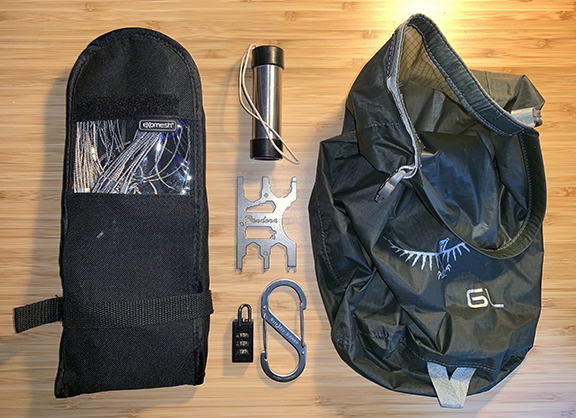
Clothing Choices
- Belt - I always wear a lightweight webbed belt. Beyond holding up my pants, I can use it for yoga stretches.
- Wool - The benefits of wearing merino wool are unsurpassed. This magic fabric is incapable of holding human body fat that causes odor. You can wear merino for a month of sweating, and the clothing will not smell. It is great for warm and cold weather. My favorite is the KÜHL KASKADE CREW.
- Cargo Pants - Modern technical fabrics mean that you might be able to get away with a single pair of pants for your travels. The Teflon-like finish sheds water and stains. Secure zip pockets serve as a wallet. Try the KÜHL KLASH PANT
- The 80-Pound Parka - There are times when luggage limits make traveling with sports equipment difficult. In these cases, I use a heavy winter parka or photographers vest as a place to stow a lot of weighty bits and pieces. I have taken the KÜHL ARKTIK PARKA to the ends of the earth, quite literally!
- What’s On Your Body - At all times, you should have your passport, credit cards and cash on your person. If the plane has an emergency landing you will not be permitted to get anything out of the overhead bin, and you might not get it back for days (this has happened to me).
- Down - If you need warmth, take it as down layers. A packable down shirt or two can be stuffed in a waterproof bag and used as a pillow. Try the KÜHL SPYFIRE JACKET. It packs really small.
- Reusable Shopping Bag - As you would at home, carry a lightweight, reusable shopping bag for food shopping or carrying and stowing jackets during flights.
- Scarf - An infinity scarf with hidden pocket is a great place to stow valuables.
- Sarongs - Sarongs can be used for warmth, as a towel, picnic blanket, a modesty cover for getting into a swimsuit, a curtain or a versatile piece of clothing.
- Quick Dry Underwear - You only need a few pairs of underwear if you can rinse and dry them fast.
- Flip flops - Take shower sandals if sharing a bathroom.
- Hat - Always take a hat to protect from the sun. Wide-brimmed hats like the KÜHL SUN DAGGER shade your nose, too.
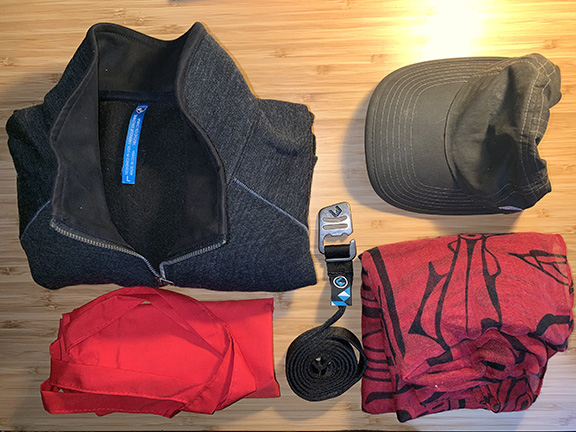
Toiletries
- Small toiletries - Use contact lens cases for vitamins, creams, hair gels, and lotions. These little containers each carry a week’s supply of anything you need, and they won’t spill.
- Toothpaste - To minimize taking a whole tube, make small dots of toothpaste and allow them to dry. Store them in contact lens cases. Put a toothpaste dot in your mouth and brush up.
- Resist Plastics - Wherever possible resist consuming single-use plastic products. Hotel shampoo bottles create an enormous waste stream. Take your own in reusable containers.
- Handkerchief - I carry a handkerchief adorned with a map of Canada. I can show people where I live, and if I need a tissue or small towel, this does the trick.
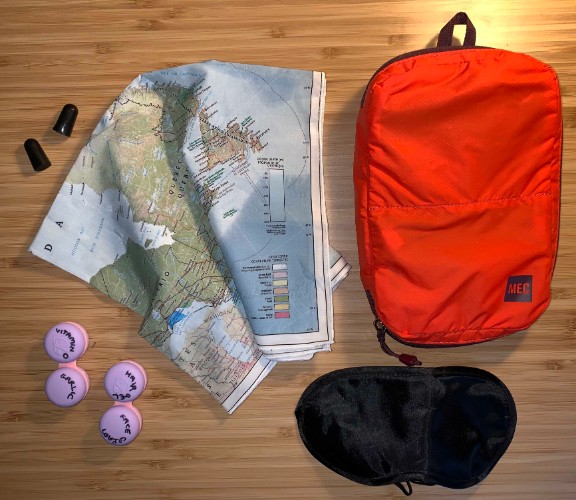
For Divers
- Camera Rinse - Use a soft cooler or inflatable cooler to protect your camera on and off the boat. It will double as a private gear rinsing tank.
- Luggage Protection - Coolers are lighter than Pelican hard cases and equally protective.
- Inflatable Padding - An inflatable camping pillow serves well as protective padding for sensitive gear and camera parts.
- Wing Safe - If you're concerned about your passport and cash when on a boat, place it in a ziplock bag and duct tape the bag well. Slide the package inside the exterior zipper on your wing or BCD. It is a natural safe that travels with you underwater.
- Dive Bags - Choosing a lightweight but sturdy dive bag is challenging. Bright interiors make it easier to find things. Wheels make travel with heavy gear possible.
- Protect Your Mask - Instead of using a mask box, slide your mask in the foot pocket of your fins to prevent breakage.
- Computers - Protect your diving computer in the second fin foot pocket or inside neoprene diving boots.
- Box in Bag - If you want extra security for camera parts, place them in a lightweight plastic toolbox or ammo case, and then put that in the duffel bag.
Little Extras

- Headlamp - One of the most useful tools is a small headlamp. Whether you're trying not to wake up your roommate in a dark hotel room or searching for parts in the bottom of a dive bag, a headlamp is extremely useful.
- Brompton - A favorite possession of mine is a Brompton folding bicycle. It fits in an overhead bin or small suitcase, and I have wheels when I get to my destination.
- Take a Boat - A professional kayaking colleague of mine travels with a cheap $100 inflatable kayak. It's small enough to put in a suitcase and capable enough for fun exploration.
- Smile - There is nothing that opens more doors than a smile.
Jill Heinerth is a Canadian cave diver, underwater explorer, writer, photographer and filmmaker. Many consider her the best female underwater explorer in the world, and she has dived in some of the most extreme locations on the planet, from underwater caves to icebergs in the frigid waters off Antarctica.


